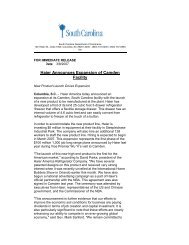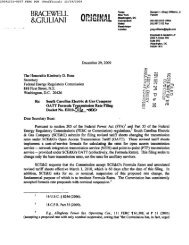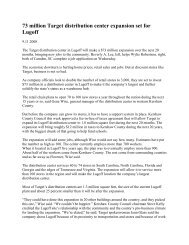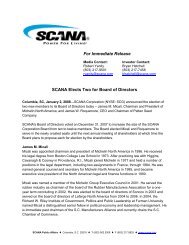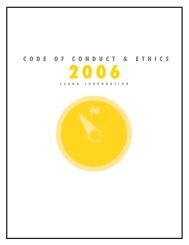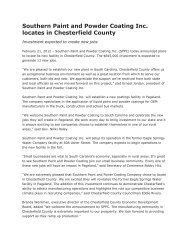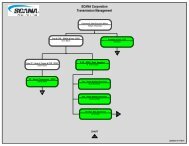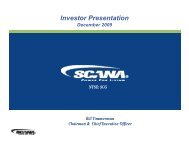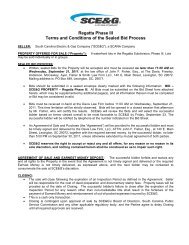10-K - SCANA Corporation
10-K - SCANA Corporation
10-K - SCANA Corporation
You also want an ePaper? Increase the reach of your titles
YUMPU automatically turns print PDFs into web optimized ePapers that Google loves.
Table of Contents<br />
environmental requirements involves significant capital and operating costs, which the Company expects to recover through existing<br />
ratemaking provisions.<br />
For the three years ended December 31, 2011, Consolidated SCE&G’s capital expenditures for environmental control<br />
equipment at its fossil fuel generating stations totaled $164.0 million. In addition, Consolidated SCE&G made expenditures to operate<br />
and maintain environmental control equipment at its fossil plants of $7.9 million during 2011, $6.5 million during 20<strong>10</strong>, and $5.6<br />
million during 2009, which are included in “Other operation and maintenance” expense and made expenditures to handle waste ash of<br />
$8.7 million in 2011, $5.9 million in 20<strong>10</strong>, and $6.5 million in 2009, which are included in “Fuel used in electric generation.” In<br />
addition, included within “Other operation and maintenance” expense is an annual amortization of $1.4 million in each of 2011, 20<strong>10</strong>,<br />
and 2009 related to SCE&G’s recovery of MGP remediation costs as approved by the SCPSC. It is not possible to estimate all future<br />
costs related to environmental matters, but forecasts for capitalized environmental expenditures for Consolidated SCE&G are $35.0<br />
million for 2012 and $126.1 million for the four-year period 2013-2016. These expenditures are included in Consolidated SCE&G’s<br />
Estimated Capital Expenditures table, are discussed in Liquidity and Capital Resources, and include known costs related to the matters<br />
discussed below.<br />
At the state level, no significant environmental legislation that would affect Consolidated SCE&G’s operations advanced<br />
during 2011. Consolidated SCE&G cannot predict whether such legislation will be introduced or enacted in 2012, or if new<br />
regulations or changes to existing regulations at the state level will be implemented in the coming year. Several regulatory initiatives<br />
at the federal level did advance in 2011 and more are expected to advance in 2012 as described below.<br />
Air Quality<br />
With the pervasive emergence of concern over the issue of global climate change as a significant influence upon the<br />
economy, Consolidated SCE&G is subject to climate-related financial risks, including those involving regulatory requirements<br />
responsive to GHG emissions, as well as those involving physical impacts which could arise from global climate change. Other<br />
business and financial risks arising from such climate change could also arise. Consolidated SCE&G cannot predict all of the climaterelated<br />
regulatory and physical risks nor the related consequences which might impact Consolidated SCE&G, and the following<br />
discussion should not be considered all-inclusive.<br />
From a regulatory perspective, Consolidated SCE&G continually monitors and evaluates current and projected emission<br />
levels and strives to comply with all state and federal regulations regarding those emissions. Consolidated SCE&G participates in the<br />
sulfur dioxide and nitrogen oxide emission allowance programs with respect to coal plant emissions and also has constructed<br />
additional pollution control equipment at several larger coal-fired electric generating plants. Further, SCE&G is engaged in preconstruction<br />
activities of the New Units which are expected to reduce GHG emission levels significantly once they are completed and<br />
dispatched by potentially displacing some of the current coal-fired generation sources.<br />
In 2005, the EPA issued the CAIR, which required the District of Columbia and 28 states, including South Carolina, to<br />
reduce nitrogen oxide and sulfur dioxide emissions in order to attain mandated state levels. CAIR set emission limits to be met in two<br />
phases beginning in 2009 and 2015, respectively, for nitrogen oxide and beginning in 20<strong>10</strong> and 2015, respectively, for sulfur dioxide.<br />
SCE&G and GENCO determined that additional air quality controls would be needed to meet the CAIR requirements. On July 6, 2011<br />
the EPA issued the CSAPR. This rule replaced CAIR and the Clean Air Transport Rule proposed in July 20<strong>10</strong> and is aimed at<br />
addressing power plant emissions that may contribute to air pollution in other states. CSAPR requires states in the eastern United<br />
States to reduce power plant emissions, specifically sulfur dioxide and nitrogen oxide. On December 30, 2011, the United States Court<br />
of Appeals for the District of Columbia issued an order staying CSAPR and reinstating CAIR pending resolution of an appeal of<br />
CSAPR. Air quality control installations that SCE&G and GENCO have already completed should assist the Company in complying<br />
with the CSAPR and the reinstated CAIR. Consolidated SCE&G will continue to pursue strategies to comply with all applicable<br />
environmental regulations. Any costs incurred to comply with this rule or other rules issued by the EPA in the future are expected to<br />
be recoverable through rates.<br />
In June 20<strong>10</strong>, the EPA issued a final rule for a one-hour ambient air quality standard for sulfur dioxide. This new standard<br />
may require some of SCE&G’s smaller coal-fired units to reduce their sulfur dioxide emissions to a level to be determined by the EPA<br />
and/or DHEC. The costs incurred to comply with this new standard are expected to be recovered through rates.<br />
Physical effects associated with climate changes could include the impact of possible changes in weather patterns, such as<br />
storm frequency and intensity, and the resultant potential damage to Consolidated SCE&G’s electric system, as well as impacts on<br />
employees and customers and on its supply chain and many others. Much of the service territory of SCE&G is subject to the damaging<br />
effects of Atlantic and Gulf coast hurricanes and also to the damaging impact of winter ice storms.<br />
<strong>10</strong>0



